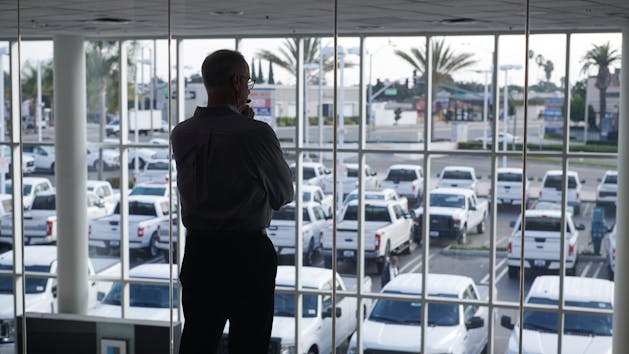Find the right solution for your business with our free Fleet Management Buyer’s Guide.
ELD Compliance: Where We Are and What’s to Come
Some of you were ready on day one. Some of you have ELD devices on the way, but the shipment hasn’t yet arrived. In the midst of it all, there are some of you who have also realized there’s more to compliance than simply having the right device installed. Now that the mandate has been official for a month or so, let’s take stock of where things stand and where ELD compliance is heading.
What you need to know about ELD compliance
The Electronic Logging Device (ELD) mandate took effect December 18, 2017,1 requiring drivers to record duty status and hours compliance using an ELD.2 And now that the mandate is in full effect, about half the states are taking a phased approach to enforcement, delaying citations or fines, and others are leaving it to officer discretion.3
For an initial 3 ½-month period, the Federal Motor Carrier Safety Administration (FMCSA) won’t place vehicles out of service for missing ELDs (until April 1, 2018) or assess points to Compliance, Safety, Accountability (CSA) scores for violations (through March 31, 2018). However, that doesn’t mean there won’t be any penalties—state and local law enforcement agencies will still be able to cite drivers or companies for driving without an ELD.4 For fleets operating in states that have not delayed fines until April 1, this could be a very real problem.
Why “soft enforcement” is still enforcement
April 1 is just around the corner, so even in fines are delayed in some jurisdictions, drivers could still face real consequences. ELD violations by trucks and drivers will still be recorded in public records, for example, which insurance companies can access and review this information. Those violations could impact insurability (independent of CSA score hits).
Down the road, companies/fleets viewing FMCSA’s pre-employment screening program could see driver ELD violations listed and use that information while making decisions about hiring. Even if the fault lies with the company they worked for that failed to roll out ELDs in time, drivers could end up paying the price.
Time is running out on the “grace” period
Given the significant changes required for fleets to comply with the ELD mandate, this phased approach and grace period made sense. However, come April 1, fleets, trucks and drivers will be subject to the full consequences of noncompliance, including having vehicles placed out of service and points assessed to CSA scores, in addition to other fines.
This extends to many industries – for example, construction fleets and contractors who manage equipment and vehicles weighing in at more than 10,000 pounds will need to equip all commercial motor vehicles (CMVs) with an ELD—including all weighing 10,000lbs+ and all transporting hazardous materials requiring placards.5
Prepare for the unknown
It may turn out that the subtle nuances of adhering to the ELD mandate will be the most challenging aspects of compliance. The most troublesome issues for both carriers and drivers are likely to be: roadside ELD data visibility, ELD system errors, ELD data diagnostic events, manner and form, personal conveyance and yard moves, lack of instruction cards, and lack of supply of blank paper logbooks.6
Fleet personnel are also coming up against mandate enforcement considerations they couldn’t have envisioned before it actually went into effect.7 A few more include:
- A new ELD Solution is actually noncompliant: To meet the quickly approaching deadline, some fleet leaders went with cheaper ELD solutions that turned out to be substandard and didn’t align with ELD requirements, even despite being listed as “registered” on the FMCSA website. Fleet managers had/have eight days to replace their devices upon realizing this or risk incurring a penalty.
- ELD technology fails: If a driver’s ELD solution fails inspection, they must be able to produce paper logs reflecting record of duty hours of service. Like noncompliant ELD technology, if newly installed ELD technology breaks, fleet managers have eight days to replace it/fix it before risking penalties.
What’s on the ELD mandate horizon?
The mandate has been official for only a few months, and yet changes are already being proposed, especially where the concept of “personal conveyance” is concerned. There’s a call for more definitive guidance in cases where drivers use commercial vehicles for personal use, and only time will tell whether clarification comes regarding this issue.
It’s clear that, while some things are set in stone, there are still of lot of growing pains associated with this new mandate and that there will be many variables to contend with in the coming months. That’s why it’s important for fleet operators and drivers both to make sure they invest in a mandate-compliant ELD solution and stay on top of the latest news and nuances to stay in compliance.
Sources
1 https://www.fmcsa.dot.gov/hours-service/elds/implementation-timeline
2 https://www.fmcsa.dot.gov/hours-service/elds/faqs
3 https://www.ccjdigital.com/inspectors-states-and-drivers-grapple-with-eld-enforcement-on-first-day-of-mandate
4 http://www.truckinginfo.com/channel/drivers/news/story/2017/12/what-eld-enforcement-could-look-like-on-day-1.aspx
5 http://www.constructionbusinessowner.com/fleet/what-your-construction-fleet-needs-know-about-elds
6 http://www.fleetowner.com/driver-logs/eld-mandate-more-changes-more-challenges-ahead
7 http://www.fleetowner.com/ideaxchange/eld-mandate-here-now-what
Find out how our platform gives you the visibility you need to get more done.




